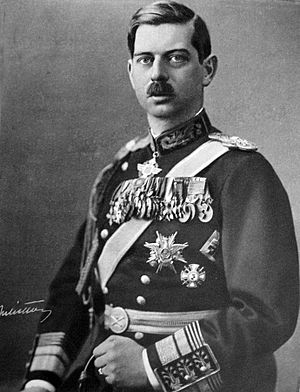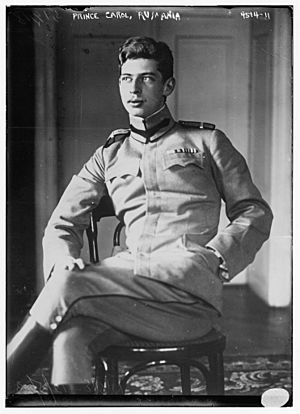Carol II of Romania facts for kids
Quick facts for kids Carol II |
|||||
|---|---|---|---|---|---|

King Carol II, c. 1935
|
|||||
| King of Romania | |||||
| Reign | 8 June 1930 – 6 September 1940 | ||||
| Predecessor | Michael I | ||||
| Successor | Michael I | ||||
| Prime Minister |
See list
Gheorghe Mironescu,
Iuliu Maniu, Nicolae Iorga, Alexandru Vaida-Voevod, Ion G. Duca, Constantin Angelescu, Gheorghe Tătărescu, Octavian Goga, Miron Cristea, Armand Călinescu, Gheorghe Argeşanu, Constantin Argetoianu, Ion Gigurtu, Ion Antonescu |
||||
| Born | 15 October 1893 Peleș Castle, Sinaia, Kingdom of Romania |
||||
| Died | 4 April 1953 (aged 59) Estoril, Portuguese Riviera, Portugal |
||||
| Burial | Royal Pantheon, Portugal (1953) Curtea de Argeș Cathedral, Romania (2003) The New Archbishopric and Royal Cathedral in Curtea de Argeș, Romania (2019) |
||||
| Spouse |
Zizi Lambrino
(m. 1918; ann. 1919) |
||||
| Issue | Carol Lambrino Michael I of Romania |
||||
|
|||||
| House | Hohenzollern-Sigmaringen | ||||
| Father | Ferdinand I of Romania | ||||
| Mother | Marie of Edinburgh | ||||
| Religion | Romanian Orthodox | ||||
Carol II (born October 15, 1893 – died April 4, 1953) was the King of Romania from 1930 to 1940. He was the oldest son of King Ferdinand I. Carol became the crown prince, meaning he was next in line for the throne, after his great-uncle, King Carol I, passed away in 1914.
Contents
Early Life of Carol II
Carol was born at Peleș Castle in Romania. He grew up largely under the care of his great-uncle, King Carol I. King Carol I did not have children of his own. He treated young Prince Carol like his own son.
King Carol I often spoiled Prince Carol. He let Carol have almost anything he wanted. Carol's mother, Crown Princess Marie, had different ideas about how he should be raised. This led to some disagreements between the King and Marie.
Carol II's Personal Life
Carol's first marriage was to Zizi Lambrino. She was the daughter of a Romanian general. They got married on August 31, 1918. At that time, Carol was serving in the army during World War I. His marriage caused some problems because he left his army duties without official permission.
Their marriage was later cancelled on March 29, 1919. However, Carol and Zizi continued to live together for a while. They had one child, Mircea Gregor Carol Lambrino, born in 1920. In 2003, a Romanian court officially recognized Mircea as Carol's legitimate son.
After this marriage ended, Carol traveled around the world. He met Princess Helen of Greece and Denmark. She was the daughter of King Constantine I of Greece. They were distant cousins. They married on March 10, 1921, and had a son, Prince Michael, that same year.
Later, Carol had a close relationship with Magda Lupescu. Because of this relationship, he decided to give up his right to become king in 1925. This meant he would no longer be next in line for the throne. His father, King Ferdinand, removed Carol's name from the royal family list. Carol then moved to France with Magda Lupescu.
When King Ferdinand died in 1927, Carol's young son, Michael, who was only 5 years old, became king. Princess Helen and Carol divorced in 1928. Carol and Elena Lupescu eventually married in Brazil in 1947.
Carol II as King
In 1930, Carol was allowed to return to Romania. There was a political crisis in the country at the time. His right to the throne was given back to him. He then took the crown from his own son, Michael, and became king.
During his time as king, Carol II tried to make the political parties weaker. He also faced issues with corruption around him.
In 1937, no single political party won enough votes in the elections. Carol used this situation to create a royal dictatorship in 1938. A dictatorship is when one person or a small group has total control over the government. Carol II got rid of the old constitution and banned all political parties. He replaced them with one single party, called the National Renaissance Front, which he controlled.
When World War II began, Carol II confirmed Romania's alliance with Poland. But after Poland was defeated, Carol II decided that Romania would stay neutral. This meant Romania would not take sides in the war.
After France was defeated in the war, Carol II tried to make an alliance with Nazi Germany. He hoped Germany would promise to protect Romania. Even though Germany did make this promise, it hurt Carol II's reputation a lot.
Giving Up the Throne
Changing Romania's foreign policy towards Nazi Germany did not save Carol II's rule. He was forced to give up his throne by General Ion Antonescu. Antonescu had just been made prime minister. Carol's son, Michael, became king again in September 1940.
Carol was allowed to leave Romania on a special train. This train was said to be carrying many valuable items. There was an attack on the train by a group called the Iron Guard, but Carol survived. After World War II, Carol II wanted to return to Romania and become king again. However, the Western Allies stopped him. He lived the rest of his life in exile.
Life in Exile
Carol first went to live in Mexico. Eventually, he settled in Portugal. While in Portugal, he lived in a town called Estoril. In Mexico City, he bought a house in a very expensive area.
During World War II, Carol tried to start a "Free Romania" movement from Mexico. He hoped this movement would help overthrow General Antonescu. Carol wanted his "Free Romania" movement to be recognized as a government that was in exile. He hoped this would lead to him becoming king again.
Interesting Facts About Carol II of Romania
- He was the first Romanian king from the Hohenzollern family who was born in Romania. The kings before him were born in Germany.
- He was the first member of the Romanian royal family to speak Romanian as his first language.
- He was also the first royal family member to be raised in the Orthodox Christian faith.
- Carol was a big fan of football. He was the president of the Romanian Football Federation for almost a year, from 1924 to 1925.
- He left his army duties without permission during World War I.
- He tried twice to give up his right to become king, but King Ferdinand refused his requests.
Death and Burial
Carol II died in Estoril, Portugal, in 1953. His coffin was placed in the Pantheon of the House of Braganza in Lisbon. In 2003, his remains were brought back to the Curtea de Argeș Cathedral in Romania. This is a traditional burial place for Romanian royalty.
Neither of his sons attended the ceremonies when his remains were moved. Carol never saw his son, King Michael, after he left Romania in 1940. Michael chose not to meet his father because of how many times Carol had upset his mother. Michael also did not go to Carol's funeral.
In 2018, it was announced that King Carol II's remains would be moved again. They were moved to the new Archdiocesan and Royal Cathedral in Curtea de Argeș. The remains of Princess Helen and Prince Mircea were also moved there. King Carol II was reburied at the new cathedral on March 8, 2019.
Images for kids
-
King Carol I of Romania with his nephew the future King Ferdinand and grand-nephew Prince Carol.
-
King Carol II, Czechoslovak President Edvard Beneš, Yugoslav regent Prince Paul, Prince Nicholas of Romania and Prince Mihai in Bucharest, 1936
-
King Carol II and Polish soldiers, 1937
-
Rabbi Teitelbaum, head of the Satmar Hasidic dynasty greeting King Carol II of Romania, 1936
See also
 In Spanish: Carlos II de Rumania para niños
In Spanish: Carlos II de Rumania para niños










